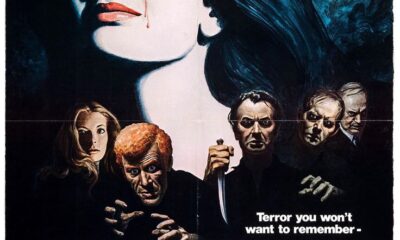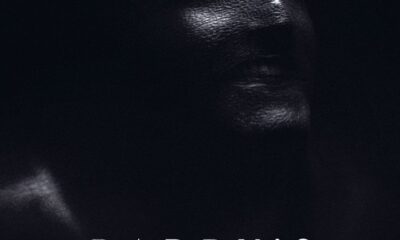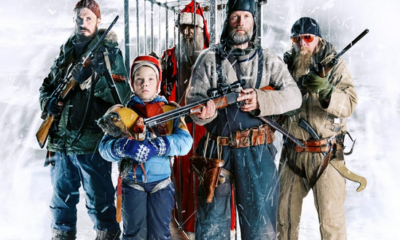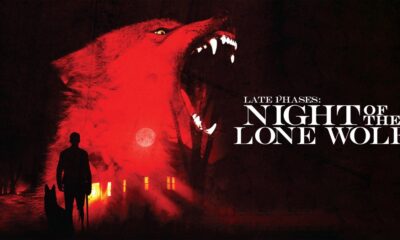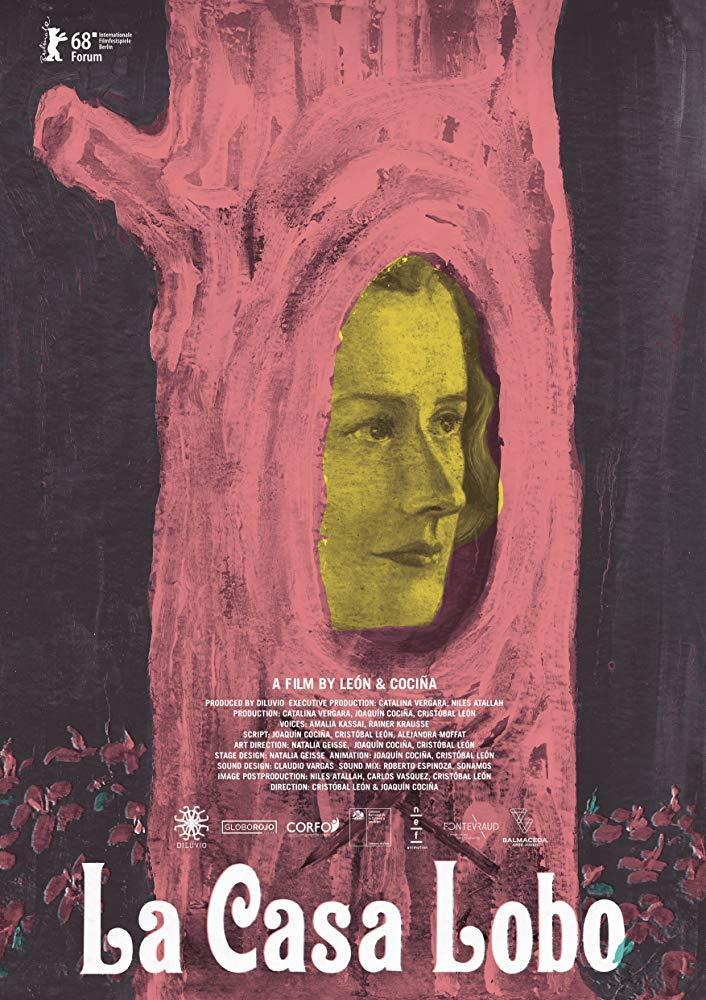
“The Wolf House” is the creepiest animated film since “Coraline”
Unless you go in knowing what it’s about, it’s hard to watch The Wolf House and understand it completely. Outside of a brief synopsis that offers a little bit of insight, nothing in the film will actually say what’s happening as it sends you on a psychedelic acid trip made out of creepy paper-mache. It’s “Three Little Pigs” meets “Red Riding Hood” set in a house in Hell. Only 75 minutes long, it feels like two hours. A Chilean stop-motion animated horror film, its natural title is La Casa Lobo, and it’s a propaganda film spoken entirely in hushed whispers.
It’s not literally a propaganda film. Kind of like a mockumentary but without the documentary part. The film is presented by a small, reclusive community in Chile that’s never named, but referred to only as “The Colony” or “The Society.” A quick dive into the film’s history, however, will reveal that the community in question is Colonia Dignidad, a real colony founded south of Santiago in 1961 by a group of Germans that fled after WWII. The leader of the colony, eventually turned cult, was Paul Schafer, a convicted pedophile and Nazi.
The film opens with an introduction that feels like those absurdly cheerful videos about “hugs not drugs” in grade school, where it’s explained to be a presentation put on by the Colony for the outside public in an attempt to “dispel the horrible rumors” about them. The brief introduction is filmed like a welcome video tour of the Colony, full of images made to look like happy Amish country, and then the actual film begins.
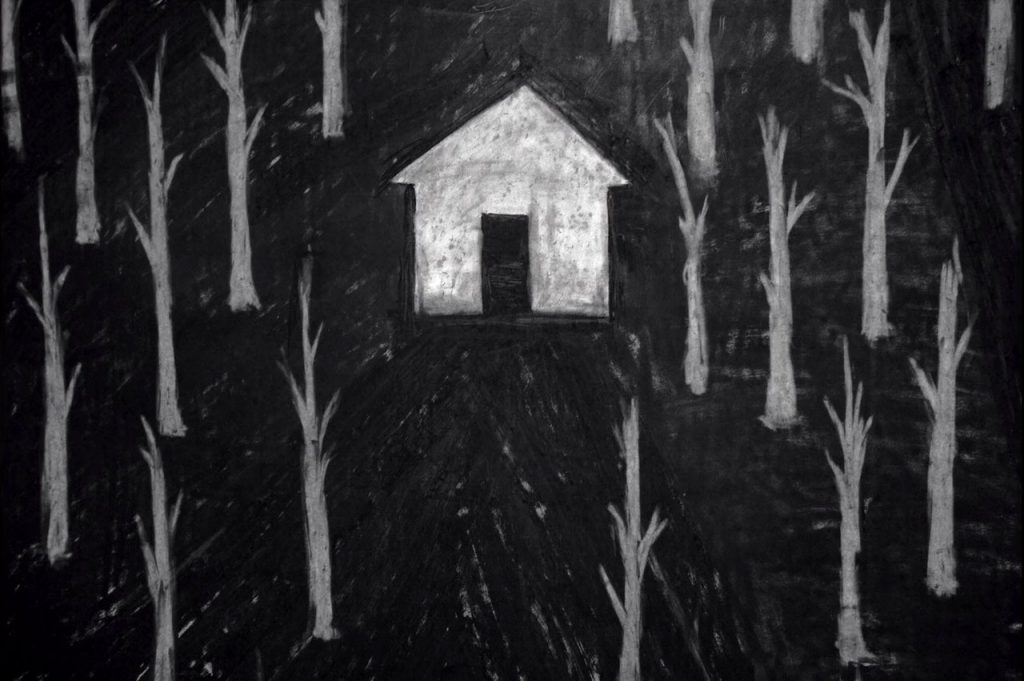
The Wolf House is very much a dark fairytale, and like any fairytale, it tells a lesson of obedience. It focuses on a young girl named Maria who one day was disobedient and punished for it. Rather than take her cruel punishment like a good girl, she flees the Colony into the surrounding wilderness for a life of independence. Not long after, a large wolf finds her and chases her deeper into the woods where she’s forced to take refuge in an abandoned house.
Inside the house, she finds two baby pigs and becomes their mother. The three end up staying there for years (maybe months, it’s never clear), as the wolf patiently waits outside. His voice, like a dark hymn, calls her name all throughout the night. “Maria. Maria. Maria,” he chants, playing nice. “I was very harsh on Maria, but it will be good for her.” He is not really a wolf but Schafer hunting her down.
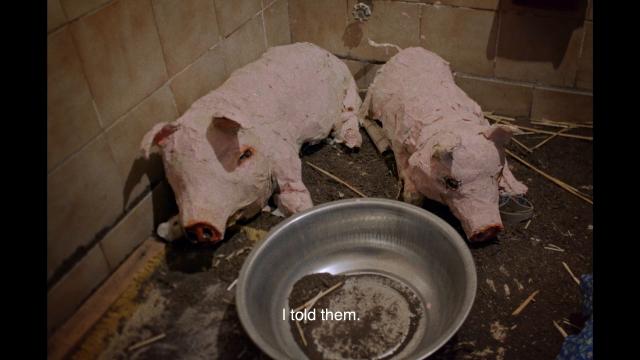
From there the film gets super surreal. It is a stop-motion animation made from paper-mache so a dreamlike creep factor was pretty much a given. The house is connected to Maria directly and changes to match her moods, fears, and thoughts. Essentially the third little pig in their strange family of three, Maria’s power to shape the world around her eventually bleeds into her two piggy adoptees as she turns them into human children. Pedro and Ana.
She’s given them life but is ill-equipped to manage it, and soon this freedom turns against her.
Themes of innocence, naivety, fear, and hunger, in more ways than one, are all on display in The Wolf House, but given the Colony’s purpose of the film, it’s all used against poor Maria. We watch Maria go from child to mother then back to a child again, from liberated survivor to frightened victim, her spirit is beaten down until she’s meant to believe that life on The Colony is actually better. As time goes on, the house and the two children become more nightmarish. They’ve grown beyond Maria’s influence and the wolf’s quiet, unseen, presence begins to suffocate her.
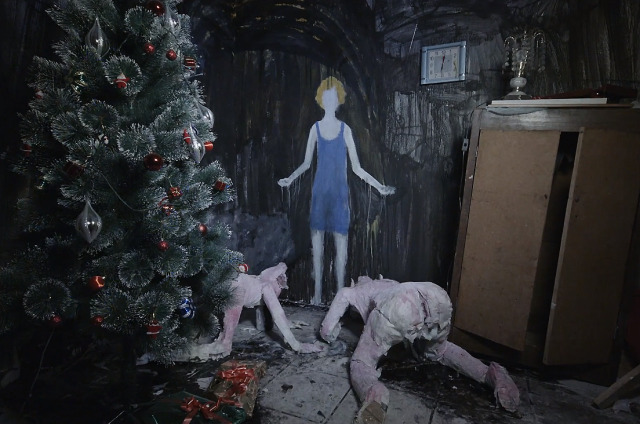
Verdict
This review’s title is actually misleading because this isn’t the creepiest animated film since Coraline, it’s much creepier than Coraline. I honestly never got what everyone liked about Coraline and never really thought it was all that frightening, even though everyone else did, but The Wolf House is definitely an eerie little film, disturbing and beautiful in its pastel-colored grotesqueness. The animation is a horror show all its own.
Watching the animation shift from form to form, accompanied by a crackling sound like a thousand cockroaches crawling up and down the walls, is just unnerving. You’ll be completely transfixed, unable to look away, and if you watch it in the dark it’ll sound like those creeping cockroaches are all around you. The icing on the cake is the film’s chosen silence. The characters whisper their dialogue as if they’re whispering for the purpose of not waking the dead.
It is an acquired taste. Not exactly fun to watch, or even that exciting. It will demand your full attention so if you aren’t willing to give it, maybe skip it. The Wolf House is directed by Cristobal León & Joaquín Cociña in their first fiction feature film co-written with Alejandra Moffat and featuring a cast of just two voices, Amalia Kassai as Maria and Rainer Krause as the Wolf.
 (5 / 5)
(5 / 5)
Photos are the property of Diluvio and Globo Rojo Films
Movies n TV
Wheel of Time A Question of Crimson Is a Political Espionage Delight
Episode two of Wheel of Time felt like the beginning of a long journey. Stories are unfolding, lives are changing, and blood is spilling.
Let’s discuss.
The story
We begin this episode in the past with Elayne’s mother, Queen Morgase. It turns out her rise to the throne was a bit, shall we say, cutthroat. So when she shows up at the White Tower, Siuan is concerned.
She might have reason to be, too.
Meanwhile, Rand, Egwene, Moiraine, Lan and Aviendha are in the Spine of The World. As they travel through some of the most breathtaking lands I have ever seen on a TV show, Egwene is plagued with nightmares. We think at first that’s just her trauma working itself through her system. But we soon find out that it might not be that straightforward.
Finally, Perrin returns home to heal after his hand is almost cut in half. But when he gets there he finds the town has been infested by Children of The Light. And they’re looking for him.
What worked
There was something heartwarming in this episode about political espionage and choking religious persecution. And that is Elayne’s relationship with her family.
I have consumed a lot of fantasy content with royal families. And I have never once heard a princess call her mother ‘Mum’. I’ve never seen royal siblings get along. And I have sure as hell never seen a princess have a good relationship with her step-parent.
This was refreshing. Even though Queen Morgase is kind of a horrible person she seems like a good mother. And that’s an unexpected delight.

Of course, this is just one storyline among many. And while this can sometimes be overwhelming, in this case it wasn’t.
I’ll be honest, some of these storylines are going to drag for me. I know this because I’ve read some of the Wheel of Time books and I have an idea that not all the characters exactly pique my interest.
No one likes all the characters. No one likes all the storylines. While I am here for the political espionage between Queen Morgase and Siuan, not everyone likes it. While others might be fascinated with Selene trying to win Rand back, I couldn’t care less.
Having multiple storylines keeps everyone’s attention better. So long as things don’t get out of hand. Things can easily get out of hand. But this seems to be managed well.
So far.
What didn’t work
As I mentioned above, I’m not thrilled with Rand’s story at this point. And while it’s fine to not like a storyline when there are this many to choose from, it’s not fantastic that the one I like the least is the one involving our two main characters. And anytime we were with the team at the Spine of The World, the only thing that brought me joy was Moirain’s hat. It reminded me of Stockard Channing’s hat in Practical Magic.
The problem is that Rand is Charlie Brown with controversial magical powers. He is boring, serious, and pessimistic.
And yes, I understand that he has a heavy emotional burden and he’s the Dragon Reborn and that’s quite taxing and all. But let’s be fair, there isn’t a single person in this show that doesn’t have a heavy burden. And most of them manage to be fun occasionally.

All that being said, this episode of Wheel of Time did exactly what it needed to do. It set up conflicts at each of the three locations. It established emotional ties between the characters and the events. And it established goals for everyone.
This was, in short, a solid episode. Not groundbreaking, not mind-blowing or life changing. It was simply good. It was entertaining and moved the plot forward.
Well done.
 (3.5 / 5)
(3.5 / 5)
Movies n TV
Wheel of Time Returns With A Bang
Wheel of Time is back for season three. There are mixed feelings regarding this. Last season, there were some serious pacing issues. And some serious sticking to the book’s storyline issues. But we’re two seasons in, and we don’t give up so easily. So let’s dive into episode one, To Race the Shadow.
By the way, I highly recommend watching this episode with the subtitles on. You’ll see why.
The story
We begin this episode with Liandrin facing a trial of sorts for her rampant betrayal. She does her best to gaslight her Aes Sedai sisters into thinking that Siuan Sanche is the real traitor.

When that doesn’t work, she reveals how many Black Aes Sedai have actually infiltrated the tower.
Spoiler, it’s a lot.
In the aftermath, our whole team gathers to drink and enjoy one night of relaxation before they head out to the Tear to form an army for Rand. All is going well until they’re attacked by myriad creatures and a sentient axe.
What worked
This episode was long. It had a run time of an hour and eleven minutes. And a lot of that run time was spent in heavy dialog scenes.
Fortunately, these were well-done scenes.
If you’re going to have a lot of talking scenes, there are good ways and bad ways to do it. Last season, we saw lots of examples of the bad way to do it. But this episode did it well. For one thing, other things were going on while conversations were taking place. The characters are drinking, playing games, walking through an interesting city. And the scenes themselves didn’t stretch out. They weren’t repetitive. We heard what the character had to say, then we moved on.
It was also nice that the point of these scenes wasn’t just info dumps. We had character development. We had romantic interactions. We had plot development and foreshadowing.
Overall, this episode felt like what it was. A moment of calm before a storm.
Taking a step back, I’d be remiss if I didn’t address the fight scene at the start of the episode. Because it was epic.
The magic looked amazing. The martial arts that went along with it looked fantastic. The costumes were beautiful. It was just incredibly fun to watch.
More than that, it was emotional. We lost some characters in that fight that were important. And it was clearly emotionally shattering for many of our characters, who found themselves betrayed by people they trusted.
So many of them.
It was a great way to open the season.
What didn’t work
Despite that, this episode wasn’t without its flaws.
First off, there were a lot of dialog scenes. And they were good scenes, as I’ve already discussed. But it was one after another after another. And when your episode is, again, an hour and eleven minutes, it’s maybe a little much to have so much chit-chat. Couldn’t some of these conversations, important as they were, have been moved to maybe another episode?
Finally, I want to talk about Egwene’s travel through the arches.

I feel like maybe there were some deleted scenes here. Because there must have been more to that visit than what we saw, right?
We could have seen Egwene battle Rand. That would have been badass and emotionally devastating. We could have seen her with a quiet life with Rand back home at the Two Rivers. We could have seen anything except for the quick clip of Rand in a bloody river, followed by Egwene being shoved back out in a bloody shift.
Bad job. But at least it wasn’t an extended scene of Moiraine collecting bathwater, and then taking a bath while looking sad. If we’d started this season with another scene like that, it might have broken my brain.
Amazon dropped the first three episodes at once. So we’ll be back soon to talk about episode two. See you then.
 (4 / 5)
(4 / 5)
Movies n TV
Entertaining as hell: Eight Legged Freaks (2002) Review
Early 2000s is a special era for the industry. It accepts the cheesiness and corniness of movie making, in turn producing some gems in their own right. Eight Legged Freaks starring David Arquette and young Scarlet Johanson is a horror comedy about giant spiders who overtake a small town. As crazy as that premise sounds, the movie surprisingly has a ton of heart and is super entertaining. Let’s review, shall we?
Plot
We start Eight Legged Freaks with a shot of toxic waste spilling into the water supply of Joshua, a spider farm owner. He is friends with Mike, one of our protagonists, who is a science geek and a spider enthusiast. Mike notices something quite right upon visiting Joshua, but no one takes him seriously. We are then introduced to the rest of the crew. Mike’s mother Samantha, the town sheriff, is too busy chasing Ashley, his sister, who is dating the town mayor’s son Bret (something Samantha does not approve of). We also have Chris, who returns to the town to save his father’s legacy in the town mines. He has opposition from Wade, Bret’s father, who wants to use the mines for his business ventures. Lots of drama going on that will only get juicier once the spiders get loose.
The creepy crawlies quickly dispose of Joshua and make their grand appearance after Ashley rejects Bret’s advances, abandoning him in the middle of a desert. A glorious chase sequence ensues as the spiders make their way towards the town, wreaking havoc on its residents. In a true horror fashion (which the movie acknowledges), it takes some convincing from Mike and then from Samantha for the town to take the threat seriously. The tongue-in-cheek style of narrative adds the comedy aspect to a movie that would otherwise burn out fairly quickly.
The remaining characters hide out in a shopping mall as it’s the only somewhat sturdy building in the area. This doesn’t last long as the spiders break in, forcing them to run through the mines. Their resources to fight the creepy crawlies off are limited as the methane gas doesn’t allow them to use firearms. Such conditions require resourceful thinking from Chris, who uses perfume to fend off the leader of the spider group and save himself during the climax of the movie.
Character dynamics are not forgotten once the action kicks in. We have Chris confessing his long-term feelings for Samantha which she knew all along, which provided some comedic relief. Bret also reunites with Ashley and apologises for being an asshole. Mike finally gets the appreciation he deserves as his knowledge saves the townsfolk more than once during the whole ordeal.
We end the movie with the town’s radio show person telling the story as an urban legend during his segment. This brings it into question – how much of it happened the way he said it did? We can only guess…
Overall thoughts
Eight Legged Freaks is a fun creature feature with some self-aware commentary on genre tropes that doesn’t take itself too seriously. The acting is good, the pacing fitting and the characters are likeable enough for you to want them to make it through. Definitely a must watch, if you don’t suffer from arachnophobia, that is.
 (5 / 5)
(5 / 5)




